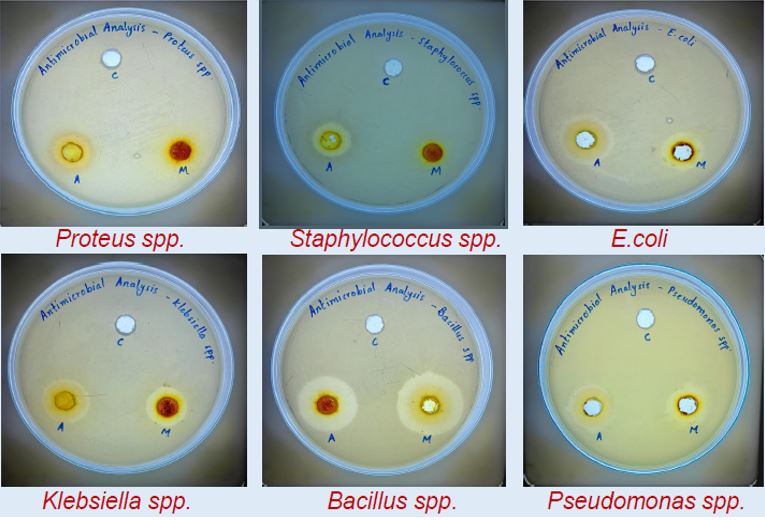Comprehensive Analysis of Allerkhand Tablet: A Novel Ayurvedic Herbal Formulation helps to regulates the Allergic Conditions
DOI:
https://doi.org/10.21760/jaims.9.8.1Keywords:
Allerkhand, Curcumin, Poly-herbal, Antimicrobial, HPTLC, HPLCAbstract
The increasing interest in alternative and complementary therapies has spotlighted Ayurveda, an ancient system of medicine, for its holistic approach in managing allergies. Ayurvedic treatments for allergy typically focus on restoring balance of the Vitiated Doshas. This may involve dietary corrections, lifestyle changes, and the use of herbal remedies and rejuvenation therapies. Curcumin, the active component of turmeric, has been extensively studied for its anti-inflammatory, antioxidant, and immunomodulatory properties, which can be beneficial in managing allergic conditions. The current study was conducted for a scientific evaluation of Allerkhand tablet, an Ayurvedic patent medicine used to treat allergy and boost immunity. Allerkhand, a poly-herbal tablet formulation with Curcuma longa as the main ingredient and 18 other constituents, serves to improve immunity by combining anti-allergic and anti-histaminic effects. The product was subjected to qualitative phytochemical HPTLC, HPLC, and anti-microbial studies. Phytochemical analysis of Allerkhand in aqueous and methanolic extracts revealed the presence of 13 and 8 common compounds, respectively. According to HPTLC and HPLC analysis, sufficient quantity of curcuminoids are present in tablets. Significant antimicrobial zones were found against six bacterial strains. These findings support the traditional use of Allerkhand tablets as a natural remedy in regulating allergic conditions.
Downloads
References
Rizvi SAA, Einstein GP, Tulp OL, Sainvil F, Branly R. Introduction to Traditional Medicine and Their Role in Prevention and Treatment of Emerging and Re-Emerging Diseases. Biomolecules 2022; 12: 1442.
Chaudhary A, Singh N. Contribution of world health organization in the global acceptance of ayurveda. J. Ayurveda Integ. Med. 2011; 2:179-86.
Ruby Pawankar, MD, Giorgio Walkter Canonica, Stephen T. Holgate, Richard F. Lockey. World Health Organization. White Book on Allergy 2011-2012: Executive Summary.
Ajay Chavan, Rahul Gujarathi, Dipti Chavan, Sumod Khedekar, Ankita Mukhedkar. llergic Rhinitis and its Explanation in Ayurveda – A Review. Pak Heart J 2023;56(02).
Sharma R, Gescher A, Steward W. Curcumin: The story so far. Eur. J. Cancer 2005; 41, 1955-1968.
Hussain Y, Alam W, Ullah H, Dacrema M, Daglia M, Khan H, Arciola CR. Antimicrobial Potential of Curcumin: Therapeutic Potential and Challenges to Clinical Applications. Antibiotics 2022; 11, 322.
Karole S, Shrivastava S, Thomas S, Soni B, Khan S, Dubey J, Dubey SP, Khan N, Jain DK, Polyherbal Formulation Concept for Synergic Action: A Review, Journal of Drug Delivery and Therapeutics. 2019; 9(1-s):453-466.
Pandey MM, Rastogi S, Rawat AKS. Indian traditional ayurvedic system of medicine and nutritional supplementation. J Evidence Based Complementary Altern Med 2013;1–12.
Garg V, Dhar VJ, Sharma A, Dutt R. Facts about standardization of herbal medicine: a review. Zhong Xi Yi Jie He Xue Bao 2012; 10:1077-83.
Srivastava S, Lal VK, Pant KK. Polyherbal formulations based on Indian medicinal plants as antidiabetic phytotherapeutics. Phytopharmacology 2012; 2:1-15.
Kapoor VK, Singla S. Herb-drug interactions–an update on synergistic interactions. J. Alt. Med. Res 2015; 1:1-11.
Santosh Ekanath Chavan, Shubhangi Katkar, Sibi Narayanan. The study of efficacy of Allerkhand (patent drug) on Sheetapitta (Urticaria). Journal of Technology. 2024; 12(3).
Anonymous, The Ayurvedic Pharmacopoeia of India, Part - I, Vol. IV. First Edition. Govt. of India, Ministry of Health and Family Welfare, Dept. of AYUSH, New Delhi; 2004. p. 159-160.
Chaudhary S, Negi A, Dahiya V. The study of in vitro antimicrobial activity and phytochemical analysis of some medicinal plants in chamoli garhwal region. Phcog. J. 2010; 2:481-485.
Evans WC. Trease & Evans. Pharmacognosy. 2009;16th edition.
Magaldi S, Mata-Essayag S, Hartung de Capriles C. Well diffusion for antifungal susceptibility testing. Int. J. Infect. Dis. 2004; 8:39-45.
Valgas C, De Souza SM, Smania EFA. Screening methods to determine antibacterial activity of natural products. Braz. J. Microbiol. 2007; 38:369-380.















